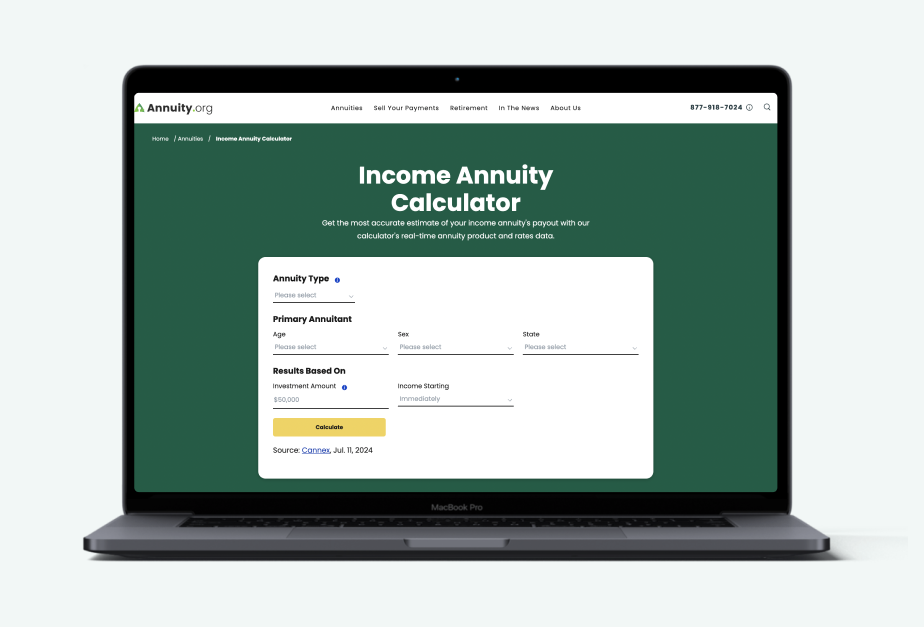Fixed annuities help people save money safely and predictably, offering a more stable option than a regular bank account or the stock market. The annuity’s term determines how many years the initial rate is guaranteed.
While annuities are similar to certificates of deposit (CDs), they have extra features that can make them even more useful, especially for long-term savings. CDs usually come with shorter time limits—typically five years or less—and any interest you earn is taxed every year. Annuities, however, can last much longer, allowing your money to grow with no taxes until you make a withdrawal. This is called tax deferral, and it helps your savings grow faster over time.
The following table shows 7-year fixed annuity rates from some of the nation’s top annuity providers.
Current Rates for a 7-Year Fixed Annuity
Loading...
| Product |
Rate
|
Guarantee Period
|
Surrender Period
|
AM Best Rating
|
|---|---|---|---|---|
|
Security Benefit Life Insurance Company Advanced Choice |
4.90% | 7 Years | 7 Years | A- |

American Freedom Aspire 7 |
5.20% | 7 Years | 7 Years | A++ |

American Freedom Classic 7 - 2025 |
5.00% | 7 Years | 7 Years | A++ |

American Pathway Fixed 7 Annuity |
4.80% | 7 Years | 7 Years | A |

American Pathway Fixed 7 Annuity |
4.85% | 7 Years | 7 Years | A |
Case Study: Buying a 7-Year Annuity
Choosing the right term for your annuity often depends on your personal and financial circumstances. This case study helps illustrate how a 7-year fixed annuity works.

John
Age: 58
Goals:
- Create a reliable income stream in retirement
- Protect principal from loss
- Lock in guaranteed growth while interest rates are high
John, 58, plans to retire at 65. He has already maximized contributions to his retirement account. However, with some saving still left to do, he seeks to further bolster his retirement nest egg.
In 2025, individuals like John, aged 50 and older, enjoy an increased 401(k) contribution limit of $31,000, compared to the standard limit of $23,500. (This increases to $32,500 in 2026.)
John has watched interest rates climb throughout the last few years and wants to take advantage before they fall again. He wants to lock in a high interest rate that’s guaranteed until he needs the money when he retires.
John investigates some options for principal-protected 7-year savings vehicles. He looks into CDs but finds that many banks don’t offer rates that are high enough or last long enough to make it to 65.
Since John is considering annuities for his retirement savings strategy, it’s important to understand that they offer tax-deferred growth, meaning he won’t owe income taxes until he withdraws money or starts receiving payments. Taxes owed will depend on whether he purchased the annuity with pre-tax or post-tax funds.
Based on these factors, John decides to purchase a 7-year fixed annuity. His savings will grow at a guaranteed rate, even if interest rates decline over the years.
When he reaches age 65, John can cash out his annuity with the interest earned or annuitize the contract, which provides a stream of income payments for several years or even for life.
7-Year Fixed Annuity vs. Indexed Annuity
When considering longer-term annuities, such as a 7-year fixed annuity, you may want to compare how other types of annuities could benefit your financial plan, as well.
For example, an indexed annuity held for seven years might accomplish many of the same goals as a 7-year fixed annuity. These products, also called fixed indexed annuities, earn interest based on two rates: a minimum fixed rate and another rate tied to the growth of a stock market index, usually the S&P 500.
The premium used to purchase an indexed annuity is never invested directly into the stock market; as a result, these annuities offer principal protection just like fixed annuities do.
“For those longer terms, you might want to look at fixed indexed [annuities] as an alternative, because you’re still 100% protected, and you do have the chance for more growth,” Nick Pangakis, a financial advisor with Capitol Financial Solutions, told Annuity.org. “Even if you’re not a market person, you can look at a chart and see that the S&P goes up three out of every four years.”
Indexed annuities usually have some limitations regarding how much of the index’s gain your contract can capture. But even with rate caps on growth, Pagnakis said, “You’re going to do better than you would in a fixed [annuity] over time.”
“For those longer terms, you might want to look at fixed indexed [annuities] as an alternative, because you’re still 100% protected and you do have the chance for more growth.”
“For those longer terms, you might want to look at fixed indexed [annuities] as an alternative, because you’re still 100% protected and you do have the chance for more growth.”
Pagnakis offered a popular strategy for cautious investors who want the gains an indexed annuity can offer while still earning a predictable return. “One of the strategies that we show people is maybe putting half in the fixed account and half in the S&P.”
Indexed annuity owners can choose how much of their premiums are allocated to a fixed percentage and how much is at the indexed rate. By putting half of the annuity’s premium into the fixed-rate account, you can ensure that even in a down year, you’ll still earn a positive interest rate on the annuity.
The downside of indexed annuities is that they are less predictable than fixed annuities. With a 7-year fixed annuity, you can know exactly how much interest you will earn over those seven years. However, it’s impossible to predict exactly how your indexed annuity will perform because you can’t predict the performance of the stock market or its indexes.
In the end, some investors are willing to weather some unpredictability for the chance to earn even more interest, while others will prefer a 7-year fixed annuity for its guaranteed interest rate.
By opting for 7-year fixed-rate annuities, you can secure a higher guaranteed interest rate over a longer period in exchange for relinquishing access to your initial investment. Additionally, you may want to consider laddering the terms of your annuities as a strategy to manage interest rate risk and liquidity risk.

See How Much You Could Earn With Today’s Best Rates
How We Get Our Rates
Annuity.org supplies fixed annuity rates through Cannex, an independent company that provides access to a database of updated annuity products.
We synchronize and update our rates information several times each week using the newest Cannex data to help ensure you have access to the most recent interest rates available.
Annuity.org features regularly updated rates for fixed annuities from one- to 10-year terms. In addition, we list the carrier offering the rate, along with its respective AM Best financial strength rating.






